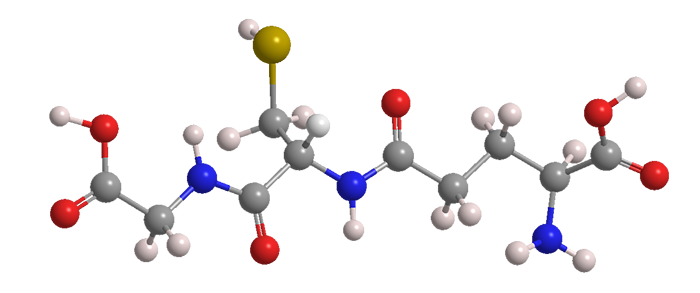What molecule am I?


Glutathione is a tripeptide that consists of the amino acids glutamic acid, cysteine, and glycine. This natural antioxidant exists in every cell of most organisms, including all animals and plants. Its reducing power comes from the thiol group in the cysteine linkage.
In 1929, Frederick Gowland Hopkins at the University of Cambridge (UK) isolated glutathione from yeast. He noted that its concentration in yeast is 0.1 wt% or greater and that the substance is also present in red blood corpuscles. The same year, Hopkins and Dutch physician Christiaan Eijkman were awarded the Nobel Prize in Physiology or Medicine for their research on the concept of vitamins*, although the only one they actually discovered was vitamin B1 (thiamine).
The first synthesis of glutathione is credited to chemist Vincent du Vigneaud of Cornell Medical College (New York City; now Weill Cornell Medicine) in 1952. Du Vigneaud was also a Nobel awardee; he won the chemistry prize in 1955 for his work on biologically important sulfur compounds.
This April, Dirk Brenner at the Luxembourg Institute of Health and coauthors in seven countries reported that, in addition to its function as an antioxidant, glutathione also stimulates T cell energy metabolism. This stimulation allows T cells to generate an optimal immune response and fight off pathogens. This discovery may lead to new therapies against cancer and autoimmune diseases.
*Polish biochemist Casimir Funk made the discovery earlier than Hopkins and Eijkman, but the Nobel committee chose not to include him in the award. See the Nobel Prize Web site for this strange story.
MOTW Update
Adenosine triphosphate (ATP) was the Molecule of the week for August 2, 2004. It has many functions in cells, but the body produces more ATP than would seem to be needed. Recently, Yamuna Krishnan at the University of Chicago, Anthony A. Hyman at the Max Planck Institute of Molecular Cell Biology & Genetics (Dresden, Germany), and co-workers discovered that ATP may have other uses. For one, it can prevent certain proteins from aggregating to form amyloid clumps.

Learn more about this molecule from CAS, the most authoritative and comprehensive source for chemical information.
Molecule of the Week needs your suggestions!
If your favorite molecule is not in our archive, please send us a message. The molecule can be notable for its current or historical importance or for any quirky reason. Thank you!
Stay Ahead of the Chemistry Curve
Learn how ACS can help you stay ahead in the world of chemistry.

